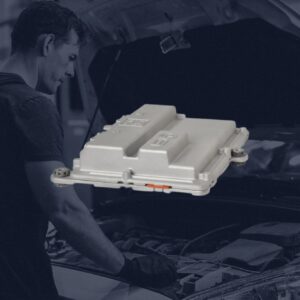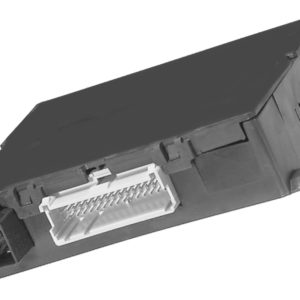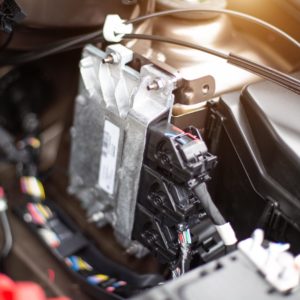Vehicles are equipped with a body control module (BCM) that monitors and controls various electronic accessories in the vehicle’s body. The BCM is very similar to the powertrain control module (PCM), but instead of monitoring engine sensors and changing engine variables, the BCM controls electronics in the vehicle’s body. These electronics include power windows, air conditioning (A/C), locks, windshield wipers, and lights.
Why Do Vehicles Have a Body Control Module?
The BCM allows many vehicle electronics to have a central hub. That said, why do vehicles have a central hub for electronics when the driver can control features like lights, air conditioning, and locks with switches on the dashboard?
Being interconnected allows the computer to control certain electronics when necessary while allowing the driver to control certain electronics individually. On newer vehicles with perimeter anti-theft, the vehicle’s security system may have sensors that can tell the computer when someone is interfering with the vehicle. The computer can then trigger the vehicle’s horn and lights to signify an alarm. At the same time, the driver can still control the vehicle’s horn and lights. Some vehicles have standalone perimeter anti-theft systems that aren’t handled through the BCM.
Like a computer, the BCM is complex and sophisticated. It’s programmed to control the various electronic accessories in the car. The BCM also constantly monitors the input signals from the sensors to ensure that the various accessories are operating properly.
The BCM can also be the hub responsible for automatically activating certain electronics based on input from certain sensors. For example, if the temperature in the cabin rises, a temperature sensor communicates the rise in temperature to the BCM, which then tells electronics like the A/C compressor to ramp up the power.

Possible Symptoms of a Faulty Body Control Module
The BCM can fail and develop various issues like the following:
Electronics Refuse to Work or Don’t Work Right
These include turn signals, windshield wipers, headlights, cabin lights, and power windows. As previously mentioned, the BCM is the hub for many features. If it fails, then it’ll likely prevent these features from functioning properly. Sometimes a BCM will keep certain lamps or some other loads illuminated all the time rather than switching them off.
Lights Flashing Randomly
If your tail lights, turn signal lights, headlights, or cabin lights turn on and off randomly, then a faulty BCM could be to blame. But don’t blame it first, without checking to make sure.
Vehicle Refuses to Lock or Unlock
The BCM is the central hub for the vehicle’s door locks and on some vehicles, the BCM handles immobilizer system functions. Immobilizer system issues aren’t typically BCM-related, but door lock and unlock issues may be. If a BCM does have issues, your vehicle might not lock or unlock properly. This issue can also interfere with vehicles equipped with keyless entry systems.
Removing both battery terminals from the battery and touching the cables together has been known to reset the BCM and fix strange electrical issues on Dodge/Chrysler platforms. However, do not connect the battery posts to each other. Just remove both cables from the battery and touch the ends of the cables together to bleed off the voltage stored in the BCM capacitors, which resets the BCM’s memory and erases trash data. The original programming is non-volatile and will always remain.
Removing both battery terminals from the battery and touching the cables together has been known to reset the BCM and fix strange electrical issues on Dodge/Chrysler platforms. However, do not connect the battery posts to each other. Just remove both cables from the battery and touch the ends of the cables together to bleed off the voltage stored in the BCM capacitors, which resets the BCM’s memory and erases trash data. The original programming is non-volatile and will always remain.
–Richard McCuistian, ASE Certified Master Automobile Technician
Warning Lights on the Dashboard
The BCM is also a hub for many vehicle sensors. So, a faulty BCM can light up a vehicle’s gauge cluster with warnings indicating an array of problems. However, these warnings might not necessarily mean that there’s something wrong with the system that the light corresponds to.
The Vehicle Refuses to Start
In rare cases, the BCM can fail to identify the transponder chip in a vehicle’s key or fail to deliver the start signal from the ignition switch. Note again, however, that this isn’t typically BCM-related, but it can be.
When BCM-related symptoms appear, you might think the body control module needs a reset. Sometimes, the BCM can glitch and cause problems. In this case, the module itself hasn’t sustained any physical damage and just needs to be reset.
Want to learn how to do a body control module reset? Automakers like Ford, Dodge, and Chevy have procedures regarding BCM resets. This typically involves disconnecting the vehicle’s battery or removing a specific fuse. That said, don’t take our word for it. You should consult your vehicle’s owner’s manual, as it’ll tell you how to do the procedure for your exact vehicle model.
However, some sources say that a faulty BCM typically warrants a replacement. Nevertheless, you generally shouldn’t drive with a faulty BCM because of the unpredictable nature of lights and electronics. You might find yourself needing your windshield, headlights, or other electronics, but the failed BCM prevents you from operating them.
On some vehicles, the BCM is also connected to safety features like the air bag system. A faulty BCM can be a safety issue since on some platforms, it can prevent your vehicle’s air bags from activating.
Finally, you might be wondering, what’s the body control module’s location? The BCM is typically located underneath the dashboard. This seems to be standard on most vehicles, as this location is near the cabin switches.
Replacing a BCM can be costly and usually requires programming by a dealer. It might be good to double-check or get a second opinion before conducting repairs.
Any information provided on this Website is for informational purposes only and is not intended to replace consultation with a professional mechanic. The accuracy and timeliness of the information may change from the time of publication.


































